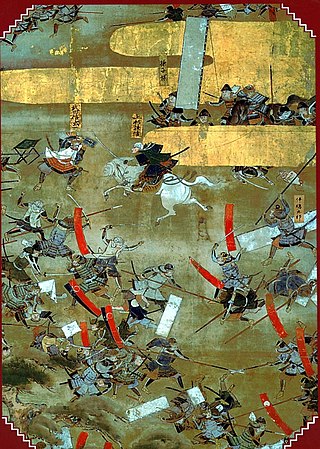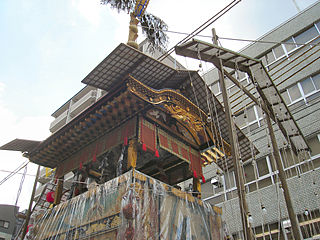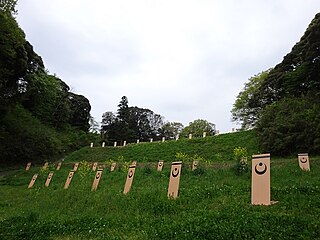
Edo, also romanized as Jedo, Yedo or Yeddo, is the former name of Tokyo.

Shogun, officially Sei-i Taishōgun, was the title of the military dictators of Japan during most of the period spanning from 1185 to 1868. Nominally appointed by the Emperor, shoguns were usually the virtual rulers of the country, although during part of the Kamakura period, shoguns were themselves figureheads, with real power in the hands of the Shikken of the Hōjō clan.

The Ashikaga shogunate, also known as the Muromachi shogunate, was the feudal military government of Japan during the Muromachi period from 1336 to 1573.

The Sengoku period is the period in Japanese history in which civil wars and social upheavals took place almost continuously in the 15th and 16th centuries. Though the Ōnin War (1467) is generally chosen as the Sengoku period's start date, there are many competing historiographies for its end date, ranging from 1568, the date of Oda Nobunaga's march on Kyoto, to the suppression of the Shimabara Rebellion in 1638, deep into what is traditionally considered the Edo period. Regardless of the dates chosen, the Sengoku period overlaps substantially with the Muromachi period (1336–1573).

The Muromachi period or Muromachi era, also known as the Ashikaga period or Ashikaga era, is a division of Japanese history running from approximately 1336 to 1573. The period marks the governance of the Muromachi or Ashikaga shogunate, which was officially established in 1338 by the first Muromachi shōgun, Ashikaga Takauji, two years after the brief Kenmu Restoration (1333–1336) of imperial rule was brought to a close. The period ended in 1573 when the 15th and last shogun of this line, Ashikaga Yoshiaki, was driven out of the capital in Kyoto by Oda Nobunaga.

Mikawa Province was an old province in the area that today forms the eastern half of Aichi Prefecture. Its abbreviated form name was Sanshū. Mikawa bordered on Owari, Mino, Shinano, and Tōtōmi Provinces.
Nirayama was a town located in Tagata District, Shizuoka Prefecture, Japan.

This is the glossary of Japanese history including the major terms, titles and events the casual reader might find useful in understanding articles on the subject.

Otogi-zōshi (御伽草子) are a group of about 350 Japanese prose narratives written primarily in the Muromachi period (1392–1573). These illustrated short stories, which remain unattributed, together form one of the representative literary genres of the Japanese medieval era.

Tozama daimyō was a class of powerful magnates or daimyō (大名) considered to be outsiders by the ruler of Japan. Tozama daimyō were classified in the Tokugawa shogunate (江戸幕府) as daimyō who became hereditary vassals of the Tokugawa after the Battle of Sekigahara (関ヶ原の戦い). Tozama daimyō were discriminated against by the Tokugawa and opposed to the fudai daimyō during the Edo period (江戸時代).
The Setsuyō-shū or Setchō-shū was a popular Muromachi period Japanese dictionary collated in iroha order and subdivided into semantic categories. The title word setsuyō means "reduce usage; economize" and alludes to the Lunyu. "Confucius said: 'If you would govern a state of a thousand chariots, you must pay strict attention to business, be true to your word, be economical in expenditure and love the people'."
Takatsukasa Sukehira was a Japanese court noble of the Edo period (1603–1868). He held the regent position of kampaku from 1787-1791.

Miyazu Domain was a feudal domain under the Tokugawa shogunate of Edo period Japan, located in Tango Province in what is now the northern portion of modern-day Kyoto Prefecture. It was centered around the Miyazu Castle which was located in what is now the city of Miyazu, Kyoto and was controlled by a number of fudai daimyō clans through its history.

Muromachi (室町), or officially Nihonbashi-Muromachi (日本橋室町), is a district of Chūō, Tokyo, Japan. It formerly belonged to the Nihonbashi Ward (日本橋区), which corresponds to the present-day Nihonbashi area.

Muromachi Street is a street in Kyoto, Japan. Originally a path called Muromachi kōji (室町小路) in Heian-kyō, the ancient capital that preceded Kyoto, it lies to the west of Karasuma Street and runs north-south from Kitayama Street in Kita-ku to Kuzebashi Street in Minami-ku. En route, it is blocked by Higashi Hongan-ji Temple and Kyoto Station.
Princess Junshi, or Shin-Muromachi-in (新室町院), was a Japanese princess and an empress consort (Chūgū) of Emperor Go-Daigo of Japan.
The Kanshō famine, was a famine which affected mostly western Japan from 1459 to 1461, during the reign of Emperor Go-Hanazono in the Muromachi period. The ruling shōgun during the famine was Ashikaga Yoshimasa. The number of deaths from starvation was at least 82,000.

Moto Sakura Castle was a Muromachi period "hirayama"-style castle located on the border of the town of Shisui and the city of Sakura, Chiba Prefecture, Japan. Its ruins been protected as a National Historic Site since 1998.
The site of Yafurai-date in Hokuto, Hokkaidō, Japan, is the grounds once occupied by the castle or fortified residence of Yafurai. Recent excavations have unearthed ceramics and other finds that help locate the site within Muromachi-period long-distance trade networks.
Hōkōshū (奉公衆) were high-ranking samurai guard-officials and close retainers (gokenin) to the Ashikaga shogun in Muromachi period Japan. The hōkōshū were made up from five guard groups, and thus were also known as gobanshū (五番衆) or simply banshū (番衆). Their role was to restrict the power of powerful regional shugo daimyo and increase their dependence on the central government.










